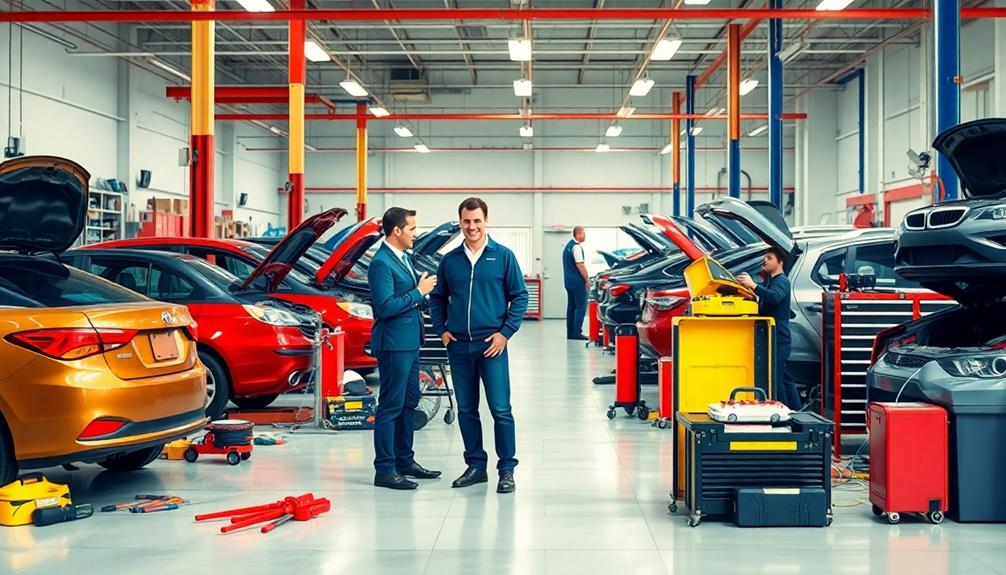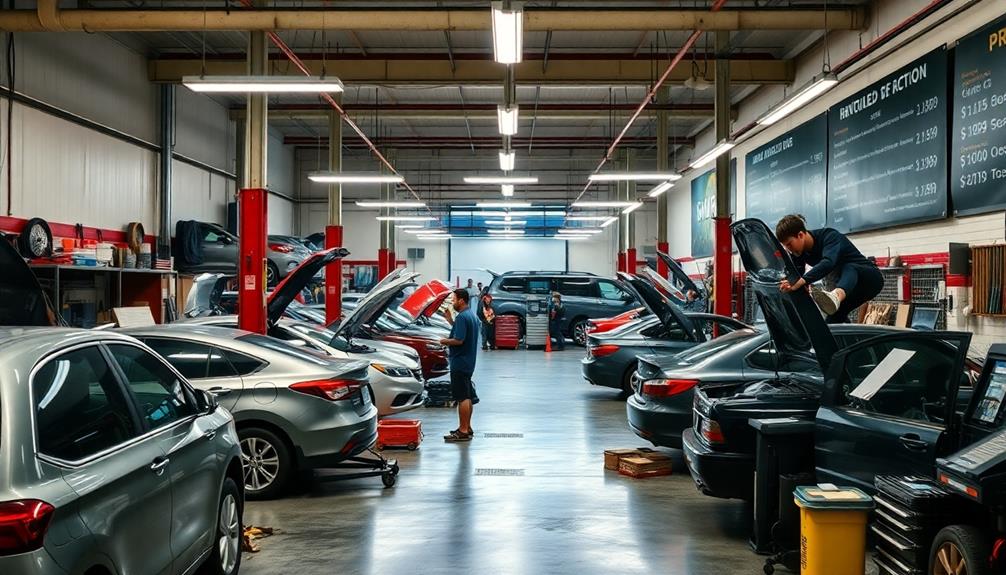Yes, the automotive repair business can be quite profitable. Many shops generate average annual revenues exceeding $1.2 million. You'll typically see gross profit margins between 20% and 30%, and healthy net profit margins range from 5% to 15%. However, half of independent shops earn less than a 5% net profit or might even operate at a loss. Factors like location, pricing strategies, and specialty services greatly impact your profitability. If you want to uncover more insights on maximizing success in this industry, there's plenty more to explore.
Key Takeaways
- Profit margins for auto repair shops typically range from 5% to 15%, indicating potential profitability.
- Average annual revenue per auto repair shop is approximately $1,226,000, suggesting strong income potential.
- Specialty services tend to yield higher profit margins than standard repairs, enhancing overall profitability.
- Effective revenue generation strategies and cost management are crucial for sustaining profits in the auto repair industry.
- Benchmarking against industry standards helps identify improvement areas to boost financial performance.
Profit Margin Terms Explained
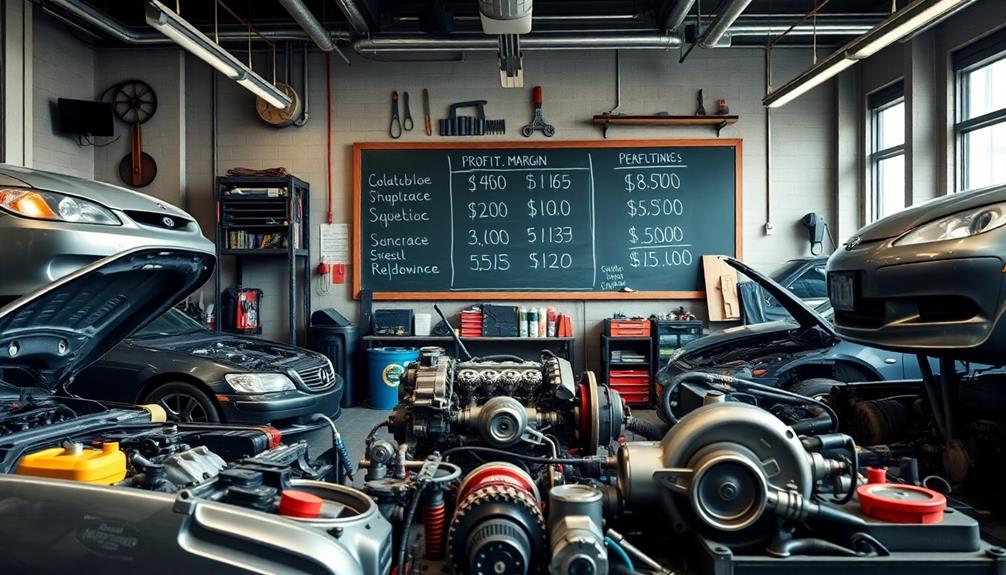
Understanding profit margins is essential for anyone in the automotive repair business. Profit margins represent how much profit you make from your total revenue after covering all expenses. To calculate your profit margin, you simply take your net profit, divide it by your total revenue, and multiply by 100. This gives you a percentage that shows how efficiently your shop is operating.
For auto repair shops, gross profit margins typically range from 20% to 30%. This figure reflects the revenue you retain after subtracting the cost of goods sold (COGS).
However, when you dig deeper into net profit margins, a healthy range falls between 5% and 15%. This indicates not just how much you're selling, but how well you're managing costs and setting prices.
Monitoring these profit margins is crucial for your shop's sustainability and growth. Sadly, around 50% of independent shops earn less than a 5% net profit or even operate at a loss.
Marking Up Parts and Labor

When it comes to running a successful automotive repair shop, marking up parts and labor effectively is crucial for maintaining profitability. Understanding how to set your parts markup and labor rates can make a significant difference in your bottom line.
Typically, parts markup ranges from 50% to 100%, depending on factors like part cost, demand, and what competitors are charging.
For labor, you'll want to guarantee your markup covers wages, benefits, and overhead. A common practice is to charge 2.5 to 3 times the technician's hourly wage. This strategy helps you remain competitive while still guaranteeing a healthy profit margin.
Consider these key points when marking up:
- Regularly analyze costs to adjust pricing strategies.
- High-demand parts can allow for higher markups, so stay informed about market trends.
- Transparency in your pricing builds customer trust and loyalty.
Typical Profit Margins Overview

While many factors influence the profitability of an automotive repair shop, typical profit margins provide essential insights into financial health. For most auto repair businesses, gross profit margins usually hover between 20% and 30%. This range largely stems from effective cost management and strategic pricing.
On the other hand, a healthy net profit margin typically falls between 5% and 15%. If you're achieving higher margins, it often indicates that you're managing costs efficiently.
Specialty services can also play a considerable role in enhancing profit margins. These services generally yield better returns compared to standard repairs, emphasizing the need for differentiation in your offerings.
Additionally, keep in mind that profit margins can vary widely based on geographic location; market saturation and local demand can greatly affect your bottom line.
Regularly benchmarking against industry standards is crucial for you to identify areas for improvement. By understanding typical profit margins, you can optimize your strategies to enhance your auto repair business's profitability.
This knowledge not only aids in maintaining financial health but also sets the groundwork for future growth.
Setting Profit Goals Effectively

To set effective profit goals, you need to analyze your historical performance and understand where you've been financially.
Establishing measurable targets based on this data will help you identify areas for improvement.
Regularly monitoring your progress allows you to adjust your strategies as needed, keeping your business on track for success.
Analyze Historical Performance
Analyzing historical performance is essential for setting effective profit goals in the automotive repair business. By reviewing your financial statements from past years, you can establish a baseline for average profit margins, which is imperative for your goal-setting process.
Here are key considerations:
- Aim for a gross profit margin of 20-30%.
- Target a net profit margin of 5-15%.
- Develop strategies for revenue increase and cost reduction.
With these benchmarks in mind, you can create a strategic plan that outlines how to achieve your profit goals. Regularly monitoring your financial performance against these targets allows you to adjust your strategies as market conditions change, ensuring ongoing profitability.
Additionally, benchmarking your performance against industry standards and top-performing auto repair shops will help you identify areas for improvement and inform realistic profit goals.
Understanding your operating costs is essential in this process, as it directly impacts your ability to maintain healthy profit margins.
Establish Measurable Targets
Establishing measurable targets is essential for effectively setting profit goals in the automotive repair business. By analyzing historical financial statements, you can create a baseline for realistic profit margin targets. Aim for a net profit margin between 5% and 15% and set specific gross profit margin targets between 20% and 30%. These targets depend on your ability to manage operating expenses and implement effective pricing strategies.
Consider external factors like location and service variations when establishing these goals. Here's a simple table to help you visualize your targets:
| Target Type | Ideal Percentage |
|---|---|
| Net Profit Margin | 5% – 15% |
| Gross Profit Margin | 20% – 30% |
| Operating Expenses | Minimized |
| Revenue Growth Goals | Specific Targets |
Regularly monitor your progress against these established profit goals. This allows you to make timely adjustments and stay aligned with market conditions. Developing an extensive plan to achieve these profit targets will emphasize increasing revenue while reducing costs—an essential step for long-term success in the automotive repair industry.
Monitor and Adjust Strategies
Keeping a close eye on your business's financial performance is essential for achieving profit goals in the automotive repair industry. By analyzing past performance, you can gauge average profit margins and set realistic targets.
Establishing specific goals for gross and net profit margins allows for measurable progress tracking, which is crucial for strategic planning.
To effectively monitor and adjust strategies, consider these key steps:
- Regularly review historical financial statements to identify trends.
- Develop a thorough plan that outlines strategies for revenue increases or cost reductions.
- Stay flexible in modifying profit goals based on operational performance and market dynamics.
Boosting Profitability With Autovitals

If you want to boost your shop's profitability, AutoVitals offers powerful tools to enhance your operations.
With Digital Vehicle Inspections, you can build trust with customers while streamlining efficiency and productivity.
Plus, performance analytics give you the insights you need to make informed decisions and drive your profit margins higher.
Digital Vehicle Inspections
Digital Vehicle Inspections (DVIs) are transforming the automotive repair landscape, making it easier for shops to build trust with customers.
With transparent, visual documentation of vehicle conditions, you can enhance customer confidence and satisfaction. Implementing DVIs isn't just about improving communication; it's a powerful way to boost your shop's profitability.
Consider these benefits of digital vehicle inspections:
- Higher Sales: DVIs can increase average repair order values by up to 30%.
- Improved Retention: Customer retention rates can rise by 20%, as clients feel informed and valued.
- Streamlined Communication: AutoVitals' DVI platform enhances interaction between technicians and customers, leading to quicker decisions.
Efficiency and Productivity Tools
Efficiency and productivity tools can greatly boost your automotive repair shop's profitability. One of the best ways to achieve this is by leveraging AutoVitals' Digital Vehicle Inspections (DVI). These inspections enhance customer trust, leading to increased sales and higher retention rates. When customers feel confident in your services, they're more likely to return.
Additionally, establishing clear savings goals for your shop can help you allocate funds towards these efficiency tools, ultimately improving your financial management. Moreover, automating your processes not only streamlines operations but also allows you to focus on creating a retirement savings plan for the long-term stability of your business.
AutoVitals also offers shop efficiency tools that streamline your operations, cutting down on wasted time. This allows your technicians to focus on productive tasks, driving profitability. With automated customer retention management features, you can foster loyalty through timely reminders and personalized offers, which encourage repeat business and elevate revenue.
In addition, the thorough platform of AutoVitals integrates various tools, improving overall shop efficiency. As you enhance customer satisfaction, you'll notice a direct impact on your bottom line. By utilizing these efficiency and productivity tools, you're not just working harder; you're working smarter.
This proactive approach helps position your shop for long-term success, ensuring you stay competitive in the automotive repair industry. Embracing these tools is essential for optimizing your operations and maximizing profitability.
Performance Analytics Insights
Performance analytics is a game-changer for automotive repair shops looking to enhance profitability. With AutoVitals' performance analytics tools, you can gain valuable insights into key performance indicators (KPIs) that directly impact your bottom line.
This data-driven approach allows you to make informed decisions that can greatly boost your financial health.
Here are some ways performance analytics can help your shop:
- Track financial metrics like gross and net profit margins to refine your strategies.
- Analyze customer retention rates to identify trends and improve service performance.
- Benchmark against industry standards to spot gaps and opportunities for improvement.
Keys to Success in Auto Repair
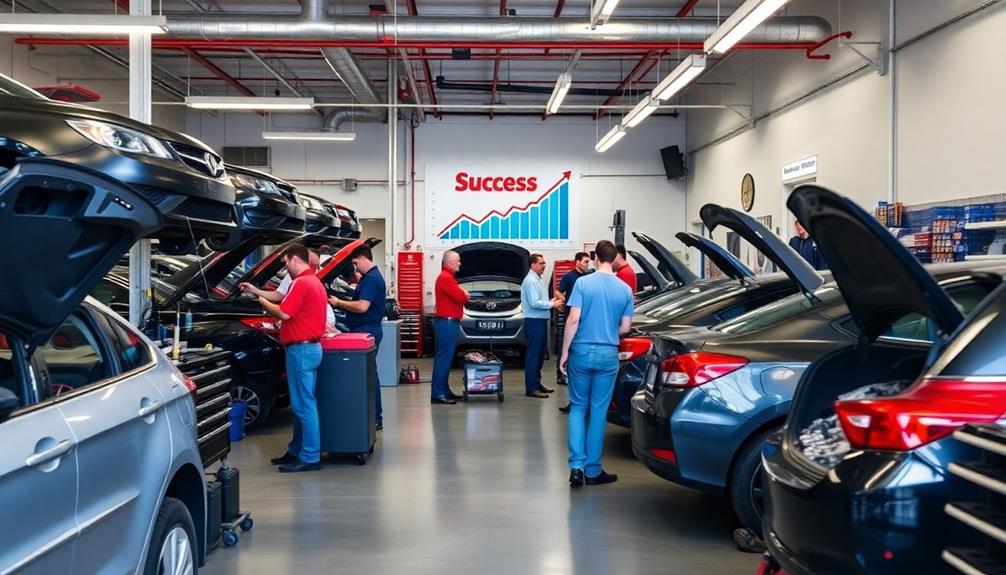
Success in the auto repair business hinges on several vital factors that can make or break your shop. First, you need sufficient seed money or access to good credit for business loans, as startup costs can range from $235,000 to $1,348,000. Choosing a high-traffic location with minimal competition is essential for attracting customers and boosting your repair services.
Next, focus on building a skilled workforce. Having technicians trained to handle a variety of vehicle types, including hybrids, is critical for providing quality service, which directly influences customer retention. A thorough menu of after-market services can also help you draw in a larger customer base and increase overall revenue.
Moreover, maintaining quality parts and fair pricing is key to your competitiveness. Profit margins on parts sales typically range between 20% and 28%, so make sure your pricing reflects both quality and value.
Franchising Opportunities With AAMCO
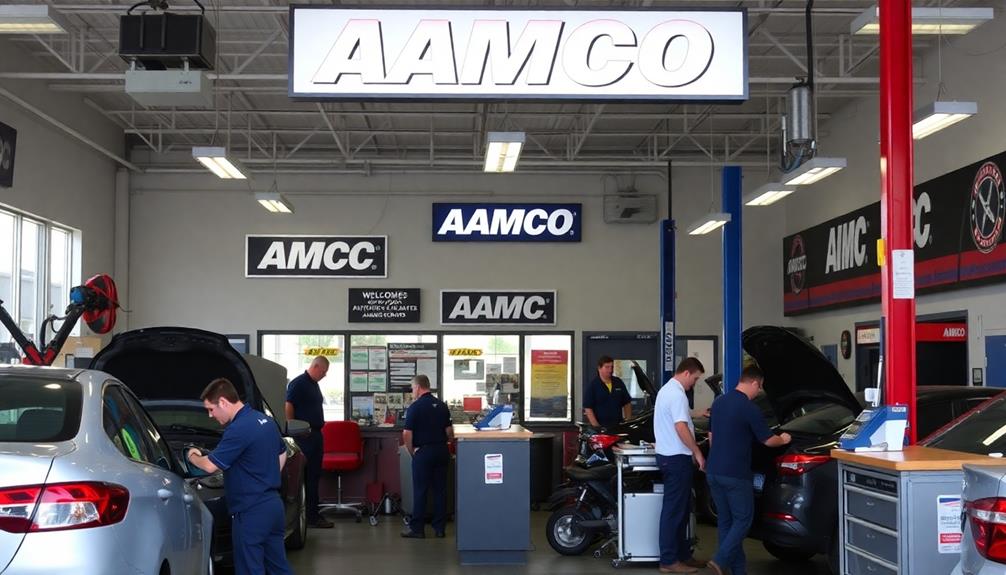
If you're considering a franchise opportunity, AAMCO stands out with its extensive training programs that equip you with essential skills in modern vehicle repair.
The brand support you receive, paired with strategic market positioning, can greatly boost your chances of success.
With AAMCO's strong reputation in the automotive repair sector, you'll be well-prepared to tap into a thriving market.
Franchisee Training Programs
AAMCO consistently offers franchisees one of the most thorough training programs in the automotive repair industry through AAMCO University.
These franchisee training programs are designed to equip you with both operational and technical skills essential for your success. You'll receive expert instruction on modern vehicle repair techniques, including advanced training for electric and hybrid systems.
The training combines classroom education with hands-on experience, ensuring you're well-prepared to manage your shop effectively.
Here are some key benefits of the AAMCO training program:
- Extensive knowledge of automotive repair and maintenance
- Ongoing support to keep you updated on industry trends
- Emphasis on building strong customer relationships for operational excellence
AAMCO's franchise model focuses on customer trust and quality service, and the training reflects this commitment.
With access to valuable resources and continuous learning opportunities, you'll be poised to thrive in the competitive automotive industry.
Joining AAMCO means you're not just running a shop; you're part of a brand dedicated to excellence and innovation in automotive repair.
Brand Support Benefits
The strength of the AAMCO brand offers franchisees a significant advantage in the competitive automotive repair market. With a nationally recognized name, especially in transmission repair, AAMCO enhances customer trust, making it easier for you to attract business. This brand support translates directly into customer loyalty and retention, essential for long-term profitability.
Franchisees benefit from thorough training at AAMCO University, equipping you and your technicians with the skills needed for modern vehicles, including electric and hybrid systems. Plus, AAMCO provides ongoing operational guidance from industry experts, guaranteeing you effectively manage daily operations.
To illustrate the key benefits of AAMCO's brand support, consider the following:
| Brand Support Feature | Benefit |
|---|---|
| National Brand Recognition | Increases customer trust |
| Thorough Training | Guarantees high-quality service |
| Ongoing Operational Guidance | Streamlines daily management |
| Extensive Marketing Resources | Boosts brand awareness |
Market Positioning Strategies
Franchising with AAMCO presents an excellent opportunity for aspiring automotive repair business owners to tap into a well-established market. AAMCO's strong brand recognition, especially in transmission services, guarantees you benefit from established customer trust.
Additionally, the automotive industry has shown resilience, making it a reliable sector for investment, much like the use of Gold IRAs as a hedge against inflation. By leveraging effective market positioning strategies, you can attract a steady stream of clients to your repair franchise.
- Extensive training at AAMCO University prepares you for modern vehicle repair, including electric and hybrid systems.
- You'll receive ongoing operational guidance and support, designed to boost your business growth and profitability.
- Strong marketing strategies and performance analytics will help you navigate challenges and maximize efficiency.
With the average annual revenue for AAMCO franchises being competitive, many franchisees report high profitability through quality service and strategic marketing.
By joining AAMCO, you not only enter a thriving sector but also gain access to invaluable resources that position your franchise for success.
Whether you're experienced or new to the industry, AAMCO equips you with the tools needed to excel in the automotive repair landscape. Embrace the opportunity to grow your business with a brand that leads the transmission repair franchise sector.
Revenue Generation Insights
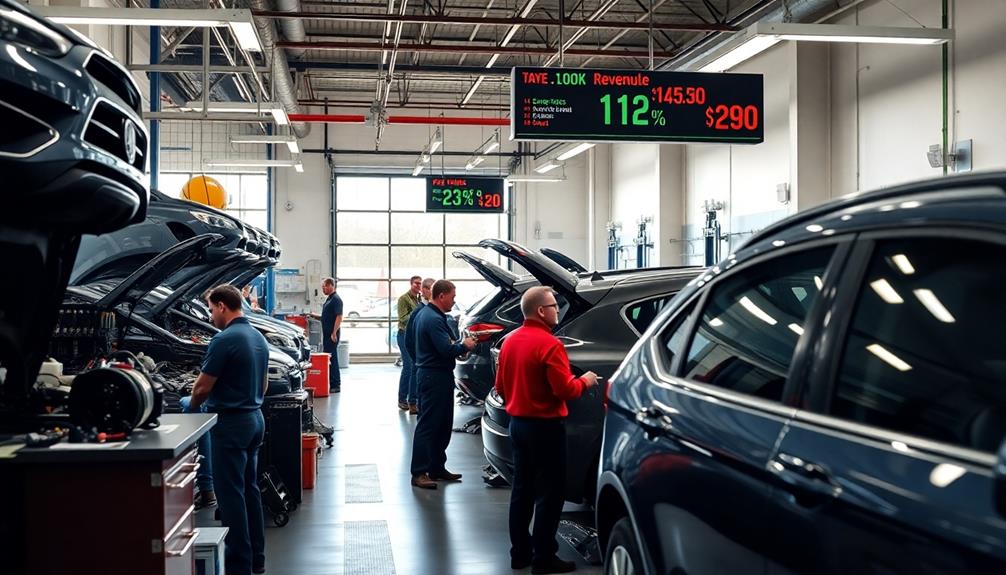
How can you gauge the profitability of an auto repair shop? Understanding revenue generation and operating profit is key. The average annual revenue per shop stands around $1,226,000, but this can vary considerably based on location and services offered. Here's a snapshot of some franchise revenue examples to help you visualize the potential:
| Franchise | Annual Revenue | Operating Profit Margin |
|---|---|---|
| Honest-1 Auto Care | $1,149,000 | 26% |
| Maaco | $1,281,000 | 26% |
| Meineke | $897,000 | 26% |
| Merlin Complete Auto Care | N/A | 38.6% |
From analyzing 2,800 businesses, the weighted average revenue is approximately $1,225,778. This provides a solid benchmark for independent shops like yours. It's crucial to target a healthy operating profit margin, with an average of 26%. By focusing on effective revenue generation strategies, you can enhance your shop's financial performance and thrive in this competitive industry.
Startup Costs Breakdown
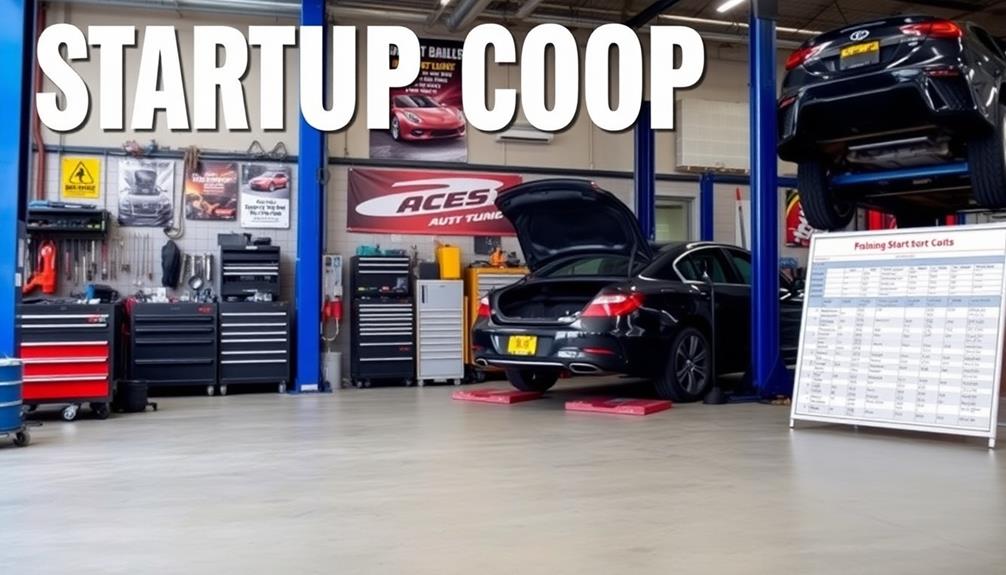
Starting an auto repair shop involves a considerable financial commitment, with average startup costs ranging from $235,000 to $1,348,000. The exact amount will depend on the size and scope of your business. Medium-sized shops typically incur startup costs estimated between $200,000 and $500,000.
Your major startup expenses will likely include:
- Equipment and Fixtures: Ranging from $131,000 to $193,000, this is a essential investment for your operations.
- Inventory Costs: These can vary greatly, estimated between $5,000 and $24,000, depending on the services you plan to offer.
- Leasehold Improvements and Miscellaneous Costs: This category includes training, advertising, signage, and permits, which can add between $8,000 and $64,000 to your budget.
Understanding these startup costs in the auto repair industry is crucial for planning your financial strategy. By accurately estimating these expenses, you can set yourself up for success and avoid unexpected financial burdens down the line.
Make sure to reflect on each of these factors carefully as you begin your journey in the auto repair business.
Running Costs and Financial Insights

Understanding the running costs of an auto repair shop is essential for your business's financial health. Key operating costs generally include Cost of Goods Sold (COGS), which can take up 25-35% of your revenue, and labor costs that range from 16-30%.
Rent and utilities typically account for 5-10% of total revenue, while marketing expenses hover around 1-5%.
Insurance premiums usually consume 2-4% of your income, and don't forget about miscellaneous costs adding another 1-3%.
With an average operating profit margin of about 26%, effective cost management is critical for maintaining profit.
To achieve a sustainable 25% net profit, keep your fixed costs below 40% of total revenue. This means you need to scrutinize each expense carefully.
By controlling your running costs, you can guarantee your profit margins remain healthy. Regularly review your financials and adjust your strategies as necessary to adapt to changing conditions.
Frequently Asked Questions
Is It Profitable to Repair Cars?
Yes, it can be profitable to repair cars. By focusing on operational efficiency, aiming for high gross margins, and providing excellent customer service, you can maximize your earnings and grow a successful automotive repair business.
Is the Auto Repair Industry Growing?
Yes, the auto repair industry is growing. With over 76 million vehicles on the road and increasing ownership duration, you'll find strong demand for maintenance services, making it a promising market for your business endeavors. Additionally, advancements in automotive technology, such as electric and autonomous vehicles, are creating new opportunities and challenges for service providers. Staying ahead of these trends will be crucial to ensuring success in the future of automotive repair shops. By adopting innovative tools and keeping technicians trained on the latest technologies, repair shops can solidify their position in this evolving industry.
How to Make More Money in an Auto Repair Shop?
To make more money in your auto repair shop, implement a parts markup strategy, optimize labor rates, offer specialty services, leverage Digital Vehicle Inspections, and continuously track performance metrics to identify improvement areas.
How Profitable Is the Automotive Industry?
In the automotive industry's engine, profitability revs high, yet varies. You'll find some shops cruising at 25% margins, while others stall below 5%. Your success hinges on savvy management and seizing market opportunities.
Conclusion
To sum up, the automotive repair business can indeed be profitable if you understand the key factors like profit margins, effective pricing strategies, and managing costs. By leveraging tools like Autovitals and considering franchising opportunities, you can enhance your revenue potential. It's not just about fixing cars; it's about running a smart, efficient operation. So, if you're ready to jump in, you'll likely find that with the right approach, success is well within your reach.
